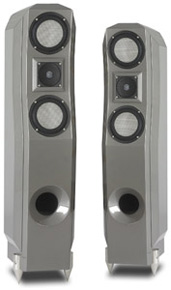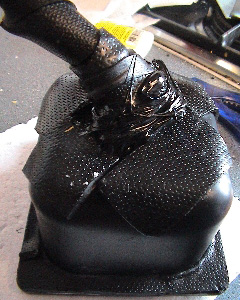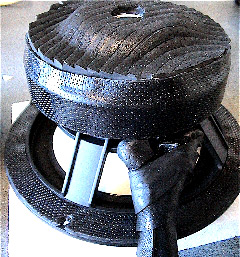 |
|
| June 15, 2006  Searching
for the Extreme: Audio Acoustics Searching
for the Extreme: Audio Acoustics
At the 2006 Consumer Electronics Show, I was fortunate to cross paths with Shabir Bhatti, of the UK’s Audio Acoustics, whose Sapphire Ti-C SE loudspeakers sounded simply fabulous. Hearing his system was one of the highlights of the event, and his exhibition was awarded a Standout Room honor in our SoundStage! A/V show coverage. I then corresponded with Bhatti for several months following the show, and now a pair of Sapphire Ti-C SEs are finally playing in my Music Vault listening room. You’ll read about my time with them soon in "The World’s Best Audio System." One thing I can tell you now is that Audio Acoustics’ products are unique, as is Shabir Bhatti. Before that article appears, I thought it worthwhile to present an inside look at a company you probably never knew existed. Audio Acoustics was founded in 1982 in West Ealing, London. Shabir Bhatti, a self-proclaimed "perfectionist and manic extremist," started the company in a small flat, selling both his own products and what he believed were the cutting-edge hi-fi products of that period: "In those days the thought of offering someone a 7W SET [single-ended triode] was most astounding to people. Alas, here we are and it only took 30 or so years for people to appreciate a well-executed SET amplifier." His hi-fi of choice back then was based on "single-ended silver triodes coupled with dynamic horns and compression drivers." Bhatti’s interest in mechanical engineering eventually overtook his desire to sell other people’s products, and he began to design his own loudspeakers. His background allowed him to "work in parallel with electrical and mechanical ideals." He says of himself, "I am a purist first and foremost and have a basic fundamental belief: one should always uncomplicate a design and replace [it] with perfected basics." This mindset, according to Bhatti, required a unique approach to designing and building loudspeakers. Bhatti believes in "[the] repeated need to go back to the beginning and redesign, removing the need to make something work. … The simplest designs, like the wheel, are the hardest to produce, yet once established are taken for granted. Yet these are the most effective and productive." Unique perspectives Shabir Bhatti has some unique perspectives on how, and how much, a loudspeaker’s cabinet contributes to its sound: "[Audio Acoustics] loudspeakers have very little in common with conventional cabinets. The research and development of our composite construction has been a substantial investment in technology over a period of eight-plus years. I have found that the cabinet is a direct extension [of] the diaphragm of a drive unit, yet paradoxically at the same time is a totally separate and active entity on its own, and with its own equilibrium in terms of energy excitement and control." Bhatti believes that simply creating a massive cabinet is not the answer. His solution is to employ multiple material layers that, when combined, offer what he feels is a better solution. "With respect to specifics, our cabinet wall is constructed from 30mm material adjacent to our polymer that controls the inception of resonances by converting them to heat; adjacent to this is another 30mm material, then an adhesive with a multilayer second and third layer membrane. Lastly is 2mm of 316 stainless-steel plate that is further bonded and substantially bolted (with 886 fasteners all torqued just so) holding the sections together. Finally there is a layer of specifically developed adhesive that attaches a third material that absorbs, redirects, and eradicates [energy] from any two points in a cabinet wall." I have no way of verifying all this, but I can say that the Sapphire Ti-C SE’s cabinet is as dead as any I’ve rapped my knuckles on, though this test is rudimentary at best.
But if you design and build something this obsessively, you must have an opinion about other products available in the marketplace, right? Bhatti has discussed with me what he feels are the strengths and weaknesses inherent in various loudspeaker types, including "The resolution and dynamics of a great horn or compression system, [which] demonstrates dynamics and clarity beyond reproach, but works only within a small bandwidth before being plagued by distortion. An alternative to this type of cabinet is the electrostatic, with its breathtaking lack of box coloration and natural transparency coupled with minuscule levels of distortion, yet again limited in bandwidth and the lack of moving enough air. ... Lastly, the conventional passive box, be it substantial in construction, lacks the other two technology merits, though [it] can move air and produce ample uncontrolled resonances at the bottom of its bandwidth. These three approaches show us how fundamental the cabinet is." At $81,000 USD per pair, the Sapphire Ti-C SE is unworldly expensive. When asked why he does not use the en-vogue diamond tweeters available to him from German manufacturer Accuton, Bhatti says, "If the driver is not allowed to function optimally, then it is irrelevant what the unit is made from. I can get substantially more out of a Sapphire’s tweeter spending the money on a competent platform structure for it to be allowed to function optimally. This is more important than buying a trophy diamond tweeter -- for marketing purposes and a spec sheet...." The speaker’s extraordinary cabinet finish was, according to Bhatti, codeveloped with a British lacquer specialist. I can attest to its striking quality. The lacquer consists of 16 coats over "a substantial base coat," sanded down and polished to a mirror finish. Audio Acoustics’ mirror-like shine must be seen in the flesh to be believed -- I know of no higher standard of finish currently available. How long does it take to produce a pair of such speakers? According to Bhatti, about 360 hours per pair. The finish alone takes 140 hours of labor. There is also extensive CNC time, the application of the resonance-controlling membranes to the various components, not to mention testing and quality control for each completed pair. Bhatti is quite proud to proclaim that his company "builds to ... nigh-on zero-tolerance" standards. On cables and such The Audio Acoustics cables are, according to Shabir Bhatti, an integral part of the sound he obtains. In fact, he has some unique thoughts on cables and their contribution to the sound of a system: "We are the first people to produce resonance-controlled cable systems. These are a fundamental extension developed from the needs of the transducer system, initially to keep the integrity of the signal within the loudspeaker system. Now we are applying this technology throughout the chain." I’ve seen these cables. Essentially, they’re wrapped in the same types of membranes Bhatti uses to effectively counter any form of vibration in his speakers. Audio Acoustics also manufactures Nano Pucks -- designed to be placed under components and the loudspeakers themselves -- and a rack system designed to eliminate resonances. They also offer a modification package for CD players "where we apply some of our membranes to the various player parts, resulting in a far more precise and distortion-free sound." The future CES 2007 will see Audio Acoustics go both up- and downmarket. First there will be a model above the Sapphire Ti-C SE, the Orb Weaver Diamond, with a price estimated at $350,000/pair. Then will follow the new baby of the line, the Zahrah, a two-way stand-mounted speaker that will retail at under $10,000/pair. Finally, 2008 will bring the statement-level Diamond Oracle to complete the lineup, at an estimated price of $900,000/pair. There is also a "radical range of prototype amplifiers that sit on the back burner ... for now." Clearly, Audio Acoustics is one company to watch. I asked Shabir Bhatti what every music lover contemplates at some point: What is your absolute reference for musical realism? He responded, "For me it’s the Queen’s royal band just up the road, or the Sally army brass band in the high street on a Saturday afternoon. And not forgetting my daughter as she insists away on her piano, always a delight ... at least most of the time! Finally, now and then I get an opportunity for an evening in the Albert Hall listening to a great symphony." With that, I’m going back to listening to the Sapphire Ti-C SEs... ...Jeff Fritz To learn more about Audio Acoustics' products, visit www.audioacoustics.co.uk.
Ultra Audio is part of the SoundStage! Network. |

